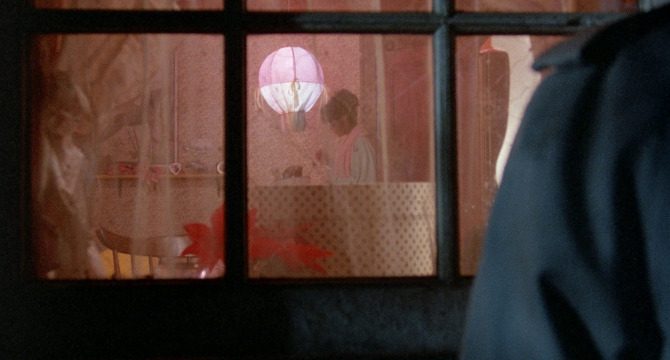With a title like The Caller (1987), one would perhaps have a preconceived notion that the Michael Sloan written (the co-creator of the television series The Equalizer), Arthur Allan Seidelman directed film would be something along the lines of the much more popular When a Stranger Calls (1979, or, if you prefer, the 2006 remake), yet, like its misleading title, nothing is what it seems.
A cerebral horror tinged mystery thriller (that may just have an unexpected dose of sci-fi), Seidelman, who would seem to be aptly named, immerses the viewer with a quarter of an hour of what amounts to a chilling silent game of stalker cat versus female mouse. Taking us from an eerily quiet town to the even more isolated rural woods, our protagonist, simply known as The Girl – reminiscent of the basic names characters were given in the silent film era (Madolyn Smith Osborne), lives in a home that, in lesser hands, would likely resemble the cabin found in the Evil Dead franchise.
Tracked by an unknown, trench coat wearing man (a combination of over the shoulder and point of view shots really ratchet up the chills), we are eventually introduced to The Caller (Malcolm McDowell – never more unnervingly polite) when he finally knocks on this woman’s door.
Claiming that his car has had some tire issues back on the deserted road, all he is seemingly looking for is to borrow the phone. Yet, our instincts are telling us that all is not right. . . and I’m not simply talking about The Caller. We almost get the idea that these two somehow know each other, an intricate and unknown (as well as possibly manipulative) game being played just beyond our understanding. It is as if both are strategizing different games of chess on separate boards, yet somehow know what the other is doing.
Both tense and terse, things escalate and then dissipate (could there even be a slight romantic chemistry between the two?). . . an unusual ebb and flow to their battle of the wits. There even seems to be a certain scoring system to this whole thing, for The Caller gives The Girl ‘points’ any time she finds a questionable detail in his supposed tale of ‘stranded driver in need of help’.
Of course, you would think after a night like this, that would be the end of it. . . but horror and thriller fans know better. The Caller keeps popping up, seen again the next time she makes her way to town, then returning to her home once more.
A tale of two, there is literally no other actor that appears in The Caller. Switching from a silent thriller to a dialogue heavy mystery, both actors are all in. A psychological battle of the wills, McDowell can at times be so sweet he is cankerous, yet, just below the surface, he is weaving the web of his tale so tightly fine that it could either snap or trap. It is hard to tell what is truth and what is lies. . . a lonely wayfaring traveler trying to get closer to an equally lonely woman, or a pathological liar with ulterior motives. Likewise, Osborne portrays her own form of a Sphinx, full of riddles and confusion. Claiming to have a guest arriving, a husband and daughter, none of these people are ever seen. . . unlucky happenstance that they are not there for the narrative’s timeline, an echo from her horrific past, herself a pathological liar. . . nothing is ever clear. The closest we can ever get is perhaps just a millisecond of a true feeling appearing in a quick glance, subtle stare, or subconscious snarl. . . the true essence of their raw emotion coming out in a slight moment of unguarded weakness.
Equally capable is Seidelman’s direction. Never boring, despite the film’s near never moving location, the camera always finds a different angle, a new tracking shot, or unique hidden nook in the cabin to explore. Likewise, his directorial skill, when combined with quality editing, Daniele Nannuzzi’s moody cinematography, and Richard Band’s emotive music, really build an effective piece.
Originally meant to get a theatrical release, The Caller instead disappeared into the great abyss (after screenings at the Cannes Film Market and a few European film festivals). . . slowly gaining a cult following across the decades. Though its unexpected ending will be divisive (likely to cause a fifty/fifty split amongst viewers), you cannot deny this eccentric, thinking man’s (or woman’s) movie. It is clever, claustrophobic, unusual, and mind bending, a find for any film buff or lover of the unknown. So, enter this twilight zone of a movie and see if you can escape its unyielding grasp.




